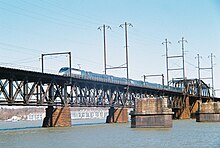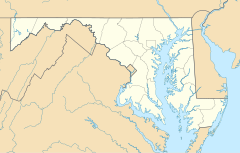Amtrak Susquehanna River Bridge
| Amtrak Susquehanna River Bridge | |
|---|---|

Southbound Acela Express crosses the bridge. The piers of the predecessor P.W. & B. Railroad Bridge are to the right.
|
|
| Coordinates | 39°33′17″N 76°05′06″W / 39.5548°N 76.0851°WCoordinates: 39°33′17″N 76°05′06″W / 39.5548°N 76.0851°W |
| Carries | Amtrak Northeast Corridor rail line |
| Crosses | Susquehanna River |
| Locale | Havre de Grace and Perryville, Maryland |
| Official name | Susquehanna River Movable Bridge |
| Maintained by | Amtrak |
| Characteristics | |
| Design | Howe deck truss |
| Material | Steel |
| Total length | 4,153 feet (1,266 m) |
| No. of spans | 18 (including center swing span) |
| Clearance below | 52 feet (15.8 m) when closed; 127 feet (38.7 m) when open |
| History | |
| Opened | May 29, 1906 |
The Amtrak Susquehanna River Bridge is a Howe deck truss structure that carries two tracks of Amtrak's Northeast Corridor line across the Susquehanna River between Havre de Grace and Perryville, Maryland.
The vicinity of the bridge has been used as a river crossing for more than 300 years. In 1695, the colonial General Assembly granted the first licenses to operate a ferry between Perryville and what is now Havre de Grace. In 1837, railroad lines south from Wilmington, Delaware, and north from Baltimore arrived at the riverbanks. For 29 years, including the duration of the American Civil War, a train ferry carried passengers (on foot) and freight cars between the two towns. In 1854, a larger ferryboat began to transport entire passenger cars across the river.
In 1866, after 12 years of intermittent construction, the Philadelphia, Wilmington, and Baltimore Railroad (PW&B) completed a wooden single-track railroad bridge. Iron reinforcements were added between 1874 and 1880. In 1881, when the Pennsylvania Railroad (PRR) formally took control of the PW&B, it cut rival Baltimore & Ohio Railroad's access to the PW&B. The B&O was forced to construct a parallel route between Baltimore and Philadelphia, including a new bridge about 1 mile (1.6 km) upstream.
...
Wikipedia

